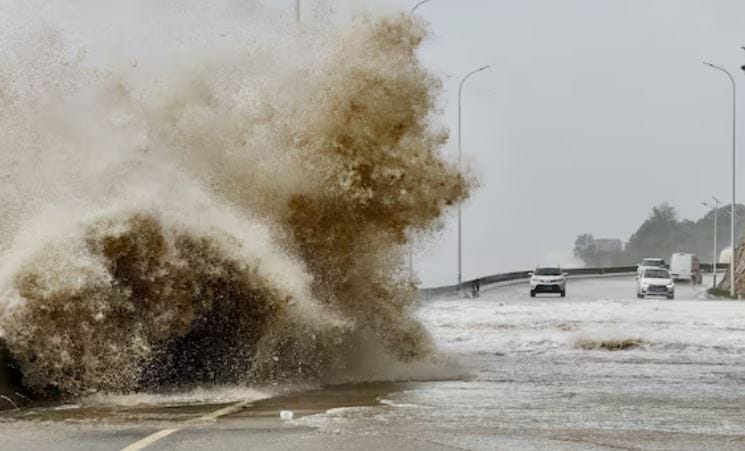Typhoon Gaemi Wreaks Havoc
Typhoon Gaemi, the most formidable storm to strike China this year, unleashed its fury on the coastal Fujian province, bringing torrential rains and powerful winds as it ventured inland. This menacing tempest, responsible for dozens of fatalities in Taiwan and exacerbating seasonal floods in the Philippines, has already impacted nearly 630,000 people in Fujian alone, necessitating the relocation of almost half of them, according to official reports.
Gaemi Downgraded but Still Dangerous
While Gaemi has been downgraded to a tropical storm due to slightly diminished wind speeds, its extensive cloud bands continue to pose a significant flood risk, particularly for rivers in central China already swollen from previous summer downpours. Scientists have issued a stark warning that global warming is intensifying tropical storms, making them less frequent but substantially more destructive.
China’s Leadership Takes Proactive Measures
In anticipation of the typhoon’s landfall, the Standing Committee of the Communist Party’s politburo, led by President Xi Jinping, convened a special meeting on flood control. This proactive measure urged officials nationwide to prioritize the protection of lives and property, with a particular emphasis on preventing breaches of major rivers and the collapse of crucial reservoirs.
Typhoon’s Impact and Future Trajectory
As a result of the typhoon’s onslaught, 72 townships across Fujian have experienced accumulated rainfall exceeding 250 mm, with some areas receiving as much as 512.8 mm. Gaemi is projected to reach Jiangxi province, home to China’s largest freshwater lake, Poyang, by late Friday. Prior to reaching China, Gaemi wreaked havoc on Taiwan, bringing super-gales, torrential rain, and widespread flooding, resulting in over 500 injuries and five fatalities.
Table: Key Points from the Article
| Key Point | Description |
|---|---|
| Typhoon Gaemi’s Intensity | Typhoon Gaemi, the strongest storm to hit China in 2024, caused devastation in Fujian province with heavy rain and strong winds. |
| Impact on Fujian Province | The typhoon affected nearly 630,000 people in Fujian, with almost half needing relocation. Despite being downgraded to a tropical storm, Gaemi’s extensive cloud bands continue to pose a significant flood risk, especially for rivers in central China. |
| Government’s Response | The Chinese government, under the leadership of President Xi Jinping, held a special meeting to address flood control and urged officials to prioritize saving lives and preventing the collapse of critical infrastructure. |
| Gaemi’s Previous Path of Destruction | Before reaching China, Gaemi caused widespread damage in Taiwan and the Philippines. It brought super-gales, heavy rain, and flooding, leading to casualties and significant infrastructure damage. |
| Scientific Warning | Scientists have warned that global warming is making tropical storms more intense, emphasizing the need for increased preparedness and mitigation measures. |
Summary: Typhoon Gaemi, a powerful storm, has wreaked havoc in China, following its destructive path through Taiwan and the Philippines. Despite being downgraded, it continues to pose a significant flood risk. The Chinese government has taken proactive measures to mitigate the impact and protect lives. This event highlights the increasing intensity of tropical storms due to global warming, underscoring the urgent need for global cooperation in addressing climate change.
Soumya Smruti Sahoo is a seasoned journalist with extensive experience in both international and Indian news writing. With a sharp analytical mind and a dedication to uncovering the truth, Soumya has built a reputation for delivering in-depth, well-researched articles that provide readers with a clear understanding of complex global and domestic issues. Her work reflects a deep commitment to journalistic integrity, making her a trusted source for accurate and insightful news coverage.



